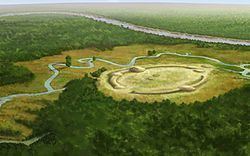Cultures Archaic period | Founded 3500 BCE | |
 | ||
Location Logtown, Louisiana, Ouachita Parish, Louisiana, USA | ||
Watson Brake is an archaeological site in Ouachita Parish, Louisiana from the Archaic period. Dated to about 5400 years ago (approx. 3500 BCE), Watson Brake is considered the earliest mound complex in North America. It is an arrangement of human-made mounds located in the floodplain of the Ouachita River near Monroe in northern Louisiana, United States. Watson Brake consists of an oval formation of eleven mounds from three to 25 feet (7.6 m) in height, connected by ridges to form an oval nearly 900 feet (270 m) across.
Contents
Map of Watson Brake, B, LA 71292, USA
Watson Brake's dating is 1,900 years before the better-known Poverty Point in Louisiana, begun about 1500 BCE and previously thought to be the earliest mound site in North America. In the Americas, mound building started at an early date.
The discovery and dating of Watson Brake as a Middle Archaic site demonstrate that the pre-agricultural, pre-ceramic, indigenous cultures within the territory of the present-day United States were much more complex than previously thought. While primarily hunter-gatherers, they were able to plan and organize large work forces over centuries to accomplish the complex mound and ridge constructions. Monumental constructions have marked the rise of social complexity world-wide. The earthen mounds of Eastern North America are linked to mankind's monument tradition.
Discovery and dating
In the early 1980s, the site was brought to the attention of professional archaeologists by Reca Bamburg Jones, a local resident, In 1981, after logging revealed more of the site, Jones identified the pattern of eleven mounds connected by ridges, a complex 280 yards across. In 1983, Jones and John Belmont published the site in a survey of pre-history in the Ouachita River Valley. Around this time Joe Saunders, then regional archaeologist for the state, was shown the site.
The site had been privately controlled since the 1950s. Approximately half the site is still owned by several family members, who have allowed archaeological excavations and associated work. Recognizing the site's significance, in 1996 The Archaeological Conservancy purchased half the site and later sold it to the state for preservation.
Since the 1990s, radiocarbon dating by a team from Northeast Louisiana University established the great antiquity of the site. The team of Joe W. Saunders et al. published a paper in Science in 1997 that established the age of the mound complex.
The analysis of 27 radiocarbon dates indicates that the site was initially occupied around 4000 BCE during the Middle Archaic period. Mound construction began at approximately 3500 BCE, and continued for approximately 500 years. During that time period, the mounds were enlarged in several stages. Excavations indicate that there was sufficient time between building episodes for midden deposits of residents to accumulate on top of the mounds and ridges. In addition, teams from the University of Texas at Austin and the University of Washington dated the site by using sand grains and organic acids in the soils.
Evidence of the middens indicate that Watson Brake may have been used as a "base by mobile hunter-gatherers from summer through fall." Saunders and his team suggest that the building episodes at Watson Brake coincide with periods of unpredictable rainfall caused by El Nino-Southern Oscillation events. They may represent "a communal response to new stresses of droughts and flooding that created a suddenly more unpredictable food base." Midden remains showed the population relied on fish, shellfish, and riverine animals, supplemented by local annuals: goosefoot (Chenopodium berlandieri), knotweed (Polygonum spp.), and possibly marshelder (Iva annua). Over time, there was an increasing consumption of terrestrial animals, such as deer, turkey, raccoon, opossum, squirrel, and rabbits, which was likely related to changing habitat and waterway conditions. The site appears to have been abandoned around 2800 BCE. This may have been caused by a "decline in the main channel, gravel/sand shoal habitats, backwater swamps, and small-stream habitats" near the site.
Together with other Middle Archaic sites in Louisiana and Florida, Watson Brake shows the development of complex societies among hunter-gatherer peoples, who occupied the site seasonally but were capable of planning and organizing complex monumental construction over a period of several hundred years.
In contrast to Poverty Point, where its residents made projectile points with materials traded from distant locations, including Wisconsin and Tennessee, the artifacts of Watson Brake show local materials and production. The projectile points are Middle to Late Archaic in age, and were produced more casually than those at Poverty Point. The people heated local gravel for cooking stones to steam some of their food. They created and fired earthenwares in a variety of shapes, but researchers have not yet determined their functions.
Ownership and management
Eight members of the Gentry family have owned most of the site since the 1950s. One member declines to sell property to the state, so the site is not available for public viewing. The family have allowed archaeologists to do research on site.
